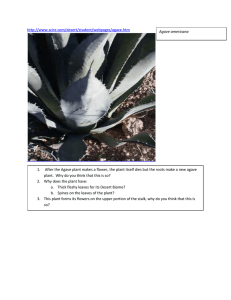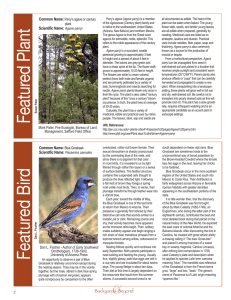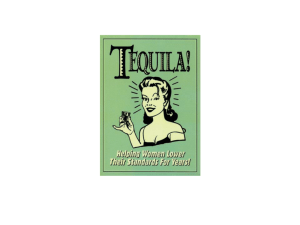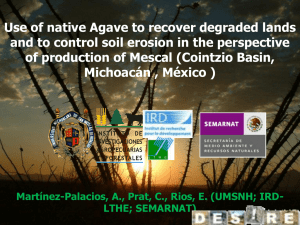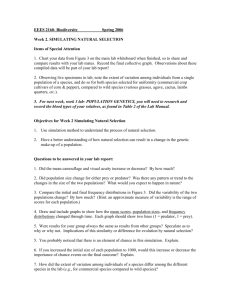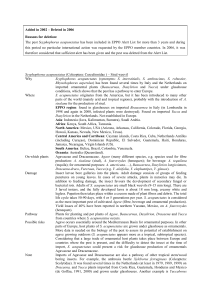USING REMOTE SENSING TO SUPPORT DIFFERENT APPROACHES TO IDENTIFY Agave tequilana
advertisement
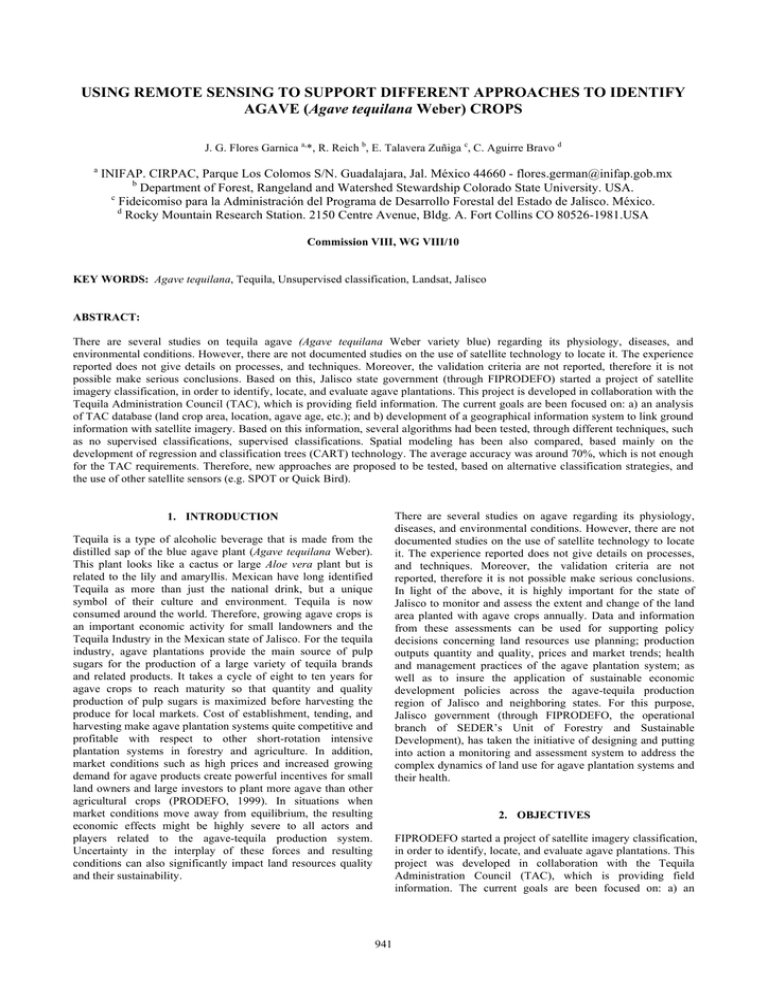
USING REMOTE SENSING TO SUPPORT DIFFERENT APPROACHES TO IDENTIFY AGAVE (Agave tequilana Weber) CROPS J. G. Flores Garnica a,*, R. Reich b, E. Talavera Zuñiga c, C. Aguirre Bravo d a INIFAP. CIRPAC, Parque Los Colomos S/N. Guadalajara, Jal. México 44660 - flores.german@inifap.gob.mx b Department of Forest, Rangeland and Watershed Stewardship Colorado State University. USA. c Fideicomiso para la Administración del Programa de Desarrollo Forestal del Estado de Jalisco. México. d Rocky Mountain Research Station. 2150 Centre Avenue, Bldg. A. Fort Collins CO 80526-1981.USA Commission VIII, WG VIII/10 KEY WORDS: Agave tequilana, Tequila, Unsupervised classification, Landsat, Jalisco ABSTRACT: There are several studies on tequila agave (Agave tequilana Weber variety blue) regarding its physiology, diseases, and environmental conditions. However, there are not documented studies on the use of satellite technology to locate it. The experience reported does not give details on processes, and techniques. Moreover, the validation criteria are not reported, therefore it is not possible make serious conclusions. Based on this, Jalisco state government (through FIPRODEFO) started a project of satellite imagery classification, in order to identify, locate, and evaluate agave plantations. This project is developed in collaboration with the Tequila Administration Council (TAC), which is providing field information. The current goals are been focused on: a) an analysis of TAC database (land crop area, location, agave age, etc.); and b) development of a geographical information system to link ground information with satellite imagery. Based on this information, several algorithms had been tested, through different techniques, such as no supervised classifications, supervised classifications. Spatial modeling has been also compared, based mainly on the development of regression and classification trees (CART) technology. The average accuracy was around 70%, which is not enough for the TAC requirements. Therefore, new approaches are proposed to be tested, based on alternative classification strategies, and the use of other satellite sensors (e.g. SPOT or Quick Bird). There are several studies on agave regarding its physiology, diseases, and environmental conditions. However, there are not documented studies on the use of satellite technology to locate it. The experience reported does not give details on processes, and techniques. Moreover, the validation criteria are not reported, therefore it is not possible make serious conclusions. In light of the above, it is highly important for the state of Jalisco to monitor and assess the extent and change of the land area planted with agave crops annually. Data and information from these assessments can be used for supporting policy decisions concerning land resources use planning; production outputs quantity and quality, prices and market trends; health and management practices of the agave plantation system; as well as to insure the application of sustainable economic development policies across the agave-tequila production region of Jalisco and neighboring states. For this purpose, Jalisco government (through FIPRODEFO, the operational branch of SEDER’s Unit of Forestry and Sustainable Development), has taken the initiative of designing and putting into action a monitoring and assessment system to address the complex dynamics of land use for agave plantation systems and their health. 1. INTRODUCTION Tequila is a type of alcoholic beverage that is made from the distilled sap of the blue agave plant (Agave tequilana Weber). This plant looks like a cactus or large Aloe vera plant but is related to the lily and amaryllis. Mexican have long identified Tequila as more than just the national drink, but a unique symbol of their culture and environment. Tequila is now consumed around the world. Therefore, growing agave crops is an important economic activity for small landowners and the Tequila Industry in the Mexican state of Jalisco. For the tequila industry, agave plantations provide the main source of pulp sugars for the production of a large variety of tequila brands and related products. It takes a cycle of eight to ten years for agave crops to reach maturity so that quantity and quality production of pulp sugars is maximized before harvesting the produce for local markets. Cost of establishment, tending, and harvesting make agave plantation systems quite competitive and profitable with respect to other short-rotation intensive plantation systems in forestry and agriculture. In addition, market conditions such as high prices and increased growing demand for agave products create powerful incentives for small land owners and large investors to plant more agave than other agricultural crops (PRODEFO, 1999). In situations when market conditions move away from equilibrium, the resulting economic effects might be highly severe to all actors and players related to the agave-tequila production system. Uncertainty in the interplay of these forces and resulting conditions can also significantly impact land resources quality and their sustainability. 2. OBJECTIVES FIPRODEFO started a project of satellite imagery classification, in order to identify, locate, and evaluate agave plantations. This project was developed in collaboration with the Tequila Administration Council (TAC), which is providing field information. The current goals are been focused on: a) an 941 The International Archives of the Photogrammetry, Remote Sensing and Spatial Information Sciences. Vol. XXXVII. Part B8. Beijing 2008 image, allows us to have a better knowledge on the zone of study, with the intention of facilitating the exploration and the suitable handling of those resources (Carmel and Kadmon, 1998). Many and varied studies of covers of the ground by means of the use of satellite images, specifically of the use of images Landsat TM7 exist (Flores, 2003). It is enough to consult the Internet to find studies of this type, all agree in the use of the two well-known techniques: supervised classification and classification unsupervised. These tools are implemented in all the systems that exist in the market for the analysis of satellite images. But have not been related publications of this type techniques to detect agave crop lands using satellite imagery. analysis of TAC database (land crop area, location, agave age, etc.); and b) development of a geographical information system to link ground information with satellite imagery. 3. BACKGROUND There are several studies of the "tequilero" agave referring to their physiology, environmental diseases, conditions, etc. (Martinez et al., 1998; Granados, 1993; Lezama, 1952). Nevertheless, there are very few reported works on detection of agave through remote sensors. Nevertheless some works have been reported on the use of images of satellite like average for the indirect detection of areas cultivated with agave, however such works have not been documented (neither process nor results). Moreover, none phase of validation is described, which discredits any conclusion that can be done. This lack of documentation has not allowed establishing clearly the strategies used in the previous attempts, which not only makes complicated to evaluate them, but to even repeat them. The strategies that have followed between the FIPRODEFO and the CRT to locate the areas with agave, in the state of Jalisco, have done on the basis of the following approaches: a) Unsupervised classification. Using this alternative, to locate the agave crop lands, the main problem is that agave crops are misclassified for low tropical forest. Therefore, we have been is working in the search of algorithms that allows to separate the plantations of agave in relation to other land covers; The departure point is the information of the Consejo Regulador del Tequila (CRT) from 1994 to 2002, such as estate, the surface, number of plants per year and the date of plantation. This information is summarized in Table 1. It is important to mention that in some agave land more than one generation occurs. Moreover, approximately 20% of the agave land were not registered in such statistics. Year Area (ha) Plants (towsands) Municipality b) Supervised classification (Shine and Wakefield, 1999). This approach was based on information generated by the CRT in order to define polygons (with agave crops) which were used as training sites. Plants/ha 1994 1995 1,368 4,144 1,801 6,031 22 38 1,317 1,455 1996 5,683 7,667 47 1,349 1997 10,190 15,315 49 1,503 1998 9,363 15,623 50 1,669 1999 9,237 14,530 50 1,573 2000 14,503 24,695 52 1,703 2001 22,372 33,144 70 1,482 2002 17,825 37,698 84 2,115 c) Using the 9,800 polygons generated by the CRT as support to develop spatial models that allows associating the characteristics of the agave crop lands with reflectance of satellite imagery. This process was based on classification and regression trees methodology (CART). Any work of classification of remote sensors unavoidably entails a verification process. In this study this activity was be supported widely by a field inventory, which was carried out by the CRT. This implies the following advantages: a) It was counted on personnel with experience in field; b) it was known where the agave cultivates are located. Also it was possible an ample distribution of the sample plots in the region where agave crops were geographically located. This allowed locating different reflectance that correspond to different conditions of agave. In addition the following information was registered: Table 1. Area and number of agave plants per year (Consejo Regulador del Tequila, 2003). An ideal use of satellite images is to be able to detect the reflectance (Bauer and Steinnocher, 2001) produced by the areas with agave crops. Moreover, been more in ambitious, someone could try to differentiate this reflectance according to the different stages of agave development (e.g. young or mature). However the answer to these questions still are not well defined, mainly because two situations: 1) there are few antecedents of the use of this techniques on agave crop land, not only in México, but anywhere in the world; 2) the existing antecedents are not documented. - Date of plantation - Species - Distance between plants - Distance between rows - Height average of the plant - Diameter average - Dead Plants - Ill Plants - Rock Cover - Colour of the ground Each one of the sites will be georeferenced, in order that serve as base for the validation of the classification which they were tested. In essence the procedure implies comparing that the areas that have been classified with agave agree with the points that were taken in field. In this way we identified areas with agave that will serve to compare and to calibrate the classifications. The procedure on the matter is widely 4. METHODOLOGY The main objective in the classification of satellite images is to obtain a right interpretation of the nature of the land (Avery, 1992). The importance of identifying the types of cover of the land (water, forest, urban areas, agave, areas, etc.) in a satellite 942 The International Archives of the Photogrammetry, Remote Sensing and Spatial Information Sciences. Vol. XXXVII. Part B8. Beijing 2008 (Townshend et al., 2000). A combination of bands 4, 5 and 6 resulted in a better discrimination of agave crop lands. Even it was possible to separate young and mature agave crops. documented, and we based it on statistical criteria like Kappa factor. First of all, we present a method of stratifying agave plantations using Landsat TM imagery to minimize the variability associated with the sampling design. For this, several algorithms had been tested, through unsupervised and supervised classifications. The average accuracy was around 70%, which could be good enough to support agave crop managing. We also used spatial modelling to compare with unsupervised and supervised classifications. This was based mainly on the development of regression and classification trees (CART) technology. Finally, we apply a two-stage cluster sampling design to sample agave plantation. Figure 2. Differences in plantation density and soil colour make difficult the location of reflectance corresponding to agave crop lands: a) Tomatlan; b) Atotonilco. 5. RESULTS Figures 3, 4 and 5 show the differences on the location of agave crop lands based on the tree approaches used in this work. It was possible to compare such results with information of polygons sampled on the ground. Which allow evaluating the precision of each methodology and make comparisons? As we can see, both supervised and unsupervised classifications produced better results than CART modelling. However, through CART it was possible to detect certain agave crop lands that were not detected with the other methodologies. The work in this strategy has consisted of the search of algorithms that allow to separate the different covers from the ground, but which allow to locate the agave crop lands as well. However, to do this we found that it is not simple, because the planted agave is not located in unique latitude (Luna, 1996). In this way we could find agave not only close to the coast, but also at the northern region of Jalisco state (semiarid lands). Because we have agave land in both plain lands, like Tequila (Villavazo, 1986) and Amatitan municipalities, and stepped lands, like Atotonilco municipality (Figure 1), it is difficult to classify satellite imagery specifically to locate agave crop lands. We also found that plant density in agave crops is not homogeneous, therefore in some places agave plants are cultivated in separated lines separated every 2 or 8 meters. This defines differences in reflectance that make difficult to discriminate agave from other land covers. Soil colour and humidity resulted in a problem for satellite imagery classification, because agave occurs in many soil types. Figure 3. Agave crop lands location based on unsupervised classification. Figure 1. Agave stands in different environmental conditions throughout the state of Jalisco: a) Plain lands (Amatitan); b) stepped lands (Atotonilco). All those components do that the agave camouflage with other covers like low tropical forest and grasslands mainly. The different densities of agave stands (with the same plant age, and assuming the same soil colour) normally define differences in reflectance (Figure 2). Moreover, we have to consider that agave can be planted in very rocky grounds, it will be understood the complexity that the modeller faces to discriminate agave crop land from other land covers. Figure 4. Agave crop lands location based on supervised classification. The handling of satellite images imply the selection of certain type of bands, in this case corresponding to the images Landsat 7 (2003), in order to test different combinations (algorithms). These algorithms allowed to emphasize different terrain features, such as water, naked ground, vegetation, etc. Results of a Monte Carlos simulation suggest that at least 30 agave plantations needed to be sampled in order to achieve a 943 The International Archives of the Photogrammetry, Remote Sensing and Spatial Information Sciences. Vol. XXXVII. Part B8. Beijing 2008 generalized additive models [GAM]) and multivariate adaptor regression spline [MARS]) should be tested. Moreover, new approaches are proposed to be tested, based on alternative classification strategies, and the use of other satellite sensors (p.e. SPOT or Quick Bird). bound on the error of estimation of 15% in estimating the density and size of agave plants. In order to evaluate, the accuracy of agave detection, the last part of this report summarizes the results of sampling the agave plantations in the field. The two most significant findings were: 1) The two-stage cluster sampling sampling design provides reliable estimates of the density and volume (height and diameter) of agave plants, and 2) the spectral reflectance of agave plantations is not directly related to the age of the plantation. REFERENCES Avery, T. E. and Berlin, G. L. 1992. Fundamentals of remote sensing and airphoto interpretation. Fifth Edition. Prentince Hall. 472 p. Bauer, T. and Steinnocher, K. 2001. Per-parcel land use classification in urban areas applying a rule-based technique. GIS: 24-27. Carmel, Y., and Kadmon, R. 1998. Computerized classification of Mediterranean vegetation using panchromatic aerial photographs. Journal of Vegetation Science, 9(3):445-454. Flores G., J. G. 2003. Spatial distribution of fuel models integrating geostatistic, GIS, and remote sensing, Agrociencia: 19 pp. Figure 5. Agave crop lands location based on classification and regression trees. Granados, S.D. 1993. Los agaves de Mèxico. Universidad Autonoma Chapingo. México. 6. CONCLUSIONS Lezama, M.M. 1952. Historia, producción, industrialización y algunas plagas de los agaves. Parasitología Agrícola. Universidad Autónoma Chapingo. Mexico. Although the resulted precision is acceptable (79-80%), we have problems with the agave reflectance, because it is very similar with other land covers, such as mesquite or grasslands. Due to this we have been continued defining algorithms that can discriminate these areas without reduction of a suitable classification of the areas planted with agave. We established the following preliminary conclusions: 1) 2) 3) 4) 5) 6) 7) 8) 9) Luna, H.G. 1996. Pudrición de tallo de Agave tequilana L. Weber en el estado de Jalisco, México. Tesis Profesional. Parasitología Agrícola. Universidad Autónoma Chapingo. México. Martínez R., J.L.; Vazquez G., M.; Pimienta B., E.; Bernal M., F.; Flores M., F.; Ibarra D., R.; Torres M., P.; Cuevas C., H.; Martin del Campo M., N. Rodríguez R., R.; Virgen C., G. 1998. Proyecto: Epidemiologia y manejo integrado de problemas fitosanitarios en Agave tequilana Weber var. Azul. Rev. Mex. Fitopatol. Vol 16 (1): 116. There are not antecedents of this type of studies in the world, which implies that its development is based on a high experimental level. It was possible to partially differentiate reflectance from agave crops in relation to other types of land cover. It was possible to differentiate, with certain precision, two stages of agave physiological development (young [3-4 years old] and mature older than 5 years). In some cases it was not possible to locate areas with young agave crops, because the surrounded vegetation affects the average reflectance. The tested algorithms do not discriminate totally agave crop lands from of other types of cover of the ground. It is necessary to establish a coordination among the diverse institutions interested in agave in order to support projects and share information. Although the results were encouraging, even requires much work in the experimentation of new methodology. It is suggested to test perspective that no t only considers the reflectance as the classification criterion, but other factors such as texture (Ryherd. and Woodcock, 1996). It is suggested to test different remote sensors. Ryherd, S. and Woodcock, C. 1996. Combining spectral and texture data in the segmentation of remotely sensed images. Photogrammetric Engineering & Remote Sensing 62(2): 181194. Shine, James A. and Wakefield, G. I. 1999. A comparison of supervised imagery classification using analyst-chosen and geostatistically-choses training sets. In Proceedings of: GeoComputing 99. 10 pp. Sowmya, A. and Trinder, J. 2000. Modelling and representation issues in automated feature extraction from aerial and satellite images. Journal of Photogrammetry & Remote Sensing 55: 3447. Townshend, J.; Huang, C.; Kalluri, S.; DeFries, R.; Liang, S. y Yang, K. 2000. Beware of per-pixel characterization of land cover. Intern. Journal of Remote Sensing 21(4): 839-843. As a general conclusion we found that there is not a unique technique to detect agave plantation, using remote sensing, therefore it is necessary to explore as many alternatives as possible. Therefore, we suggest that in further projects other techniques (such as artificial neural network [ANN], Villalvazo R., A.S. 1986. El cultivo del mezcal (Agave tequilana L. Weber) en la región de Tequila, Jalisco. Departamento de Fitotecnia. Universidad Autónoma Chapingo. México. 944
